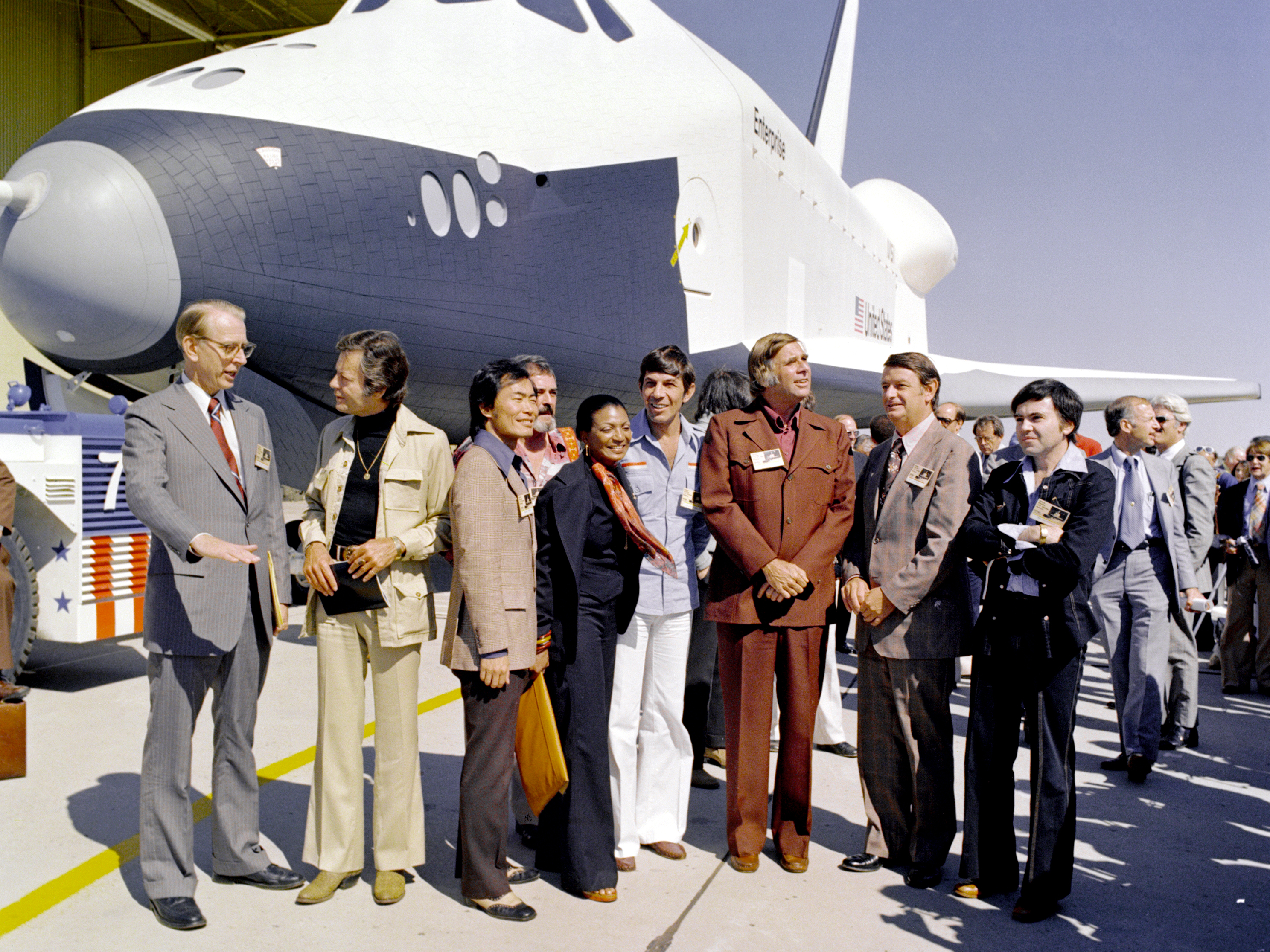The ''Star Trek'' media franchise is a multibillion-dollar industry, owned by CBS. Gene Roddenberry sold ''Star Trek'' to NBC as a classic adventure drama; he pitched the show as "''Wagon Train'' to the Stars" and as Horatio Hornblower - wikipedia ![]()
in Space. The opening line, "to boldly go where no man has gone before," was taken almost verbatim from a U.S. White House booklet on space produced after the ''Sputnik'' flight in 1957. The central trio of Kirk, Spock, and McCoy (Leonard McCoy) was modeled on classical mythological storytelling.

The Shuttle Enterprise rolls out of the Palmdale manufacturing facilities with Star Trek television cast members. From left to right they are: Dr. James C. Fletcher (NASA Administrator), DeForest Kelley (Dr. "Bones" McCoy), George Takei (Mr. Sulu), James Doohan (Chief Engineer Montgomery "Scotty" Scott), Nichelle Nichols (Lt. Uhura), Leonard Nimoy (the indefatigable Mr. Spock), Gene Roddenberry (The Great Bird of the Galaxy), an unnamed official (probably from the NASA), and Walter Koenig (Ensign Pavel Chekov). - wikimedia ![]() - wikimedia
- wikimedia ![]()
''Star Trek'' and its spin-offs have proven highly popular in syndication and are shown on TV stations worldwide.TREK NATION — Rich Text Format ![]() The show's cultural impact goes far beyond its longevity and profitability. ''Star Trek'' conventions (science fiction convention) have become popular among its fans (Official Star Trek Fan Club), who call themselves "trekkies" or "trekkers" (trekkie). An entire subculture has grown up around the show which was documented in the film ''Trekkies (Trekkies (film))''. ''Star Trek'' was the highest-ranked cult show by ''TV Guide''.TV Guide Names the Top Cult Shows Ever
The show's cultural impact goes far beyond its longevity and profitability. ''Star Trek'' conventions (science fiction convention) have become popular among its fans (Official Star Trek Fan Club), who call themselves "trekkies" or "trekkers" (trekkie). An entire subculture has grown up around the show which was documented in the film ''Trekkies (Trekkies (film))''. ''Star Trek'' was the highest-ranked cult show by ''TV Guide''.TV Guide Names the Top Cult Shows Ever ![]() The franchise has also garnered many comparisons (Comparison of Star Trek and Star Wars) of the ''Star Wars'' franchise being rivals in the science fiction genre with many fans and scholars.Star Wars Vs. Star Trek
The franchise has also garnered many comparisons (Comparison of Star Trek and Star Wars) of the ''Star Wars'' franchise being rivals in the science fiction genre with many fans and scholars.Star Wars Vs. Star Trek ![]() The Race to Create a Real-Life Tricorder
The Race to Create a Real-Life Tricorder ![]()
The ''Star Trek'' franchise inspired some designers of technologies, the Palm PDA (Palm OS) and the handheld mobile phone.editinternational ![]() Michael Jones, Chief technologist of Google Earth, has cited the tricorder's mapping capability as one inspiration in the development of Keyhole/Google Earth.Google Earth inspiration was Star Treks Tricorder
Michael Jones, Chief technologist of Google Earth, has cited the tricorder's mapping capability as one inspiration in the development of Keyhole/Google Earth.Google Earth inspiration was Star Treks Tricorder ![]() The Tricorder X Prize, a contest to build a medical tricorder device was announced in 2012. Ten finalists have been selected in 2014, and the winner will be selected in January 2016. ''Star Trek'' also brought teleportation to popular attention with its depiction of "matter-energy transport", with the famously misquoted phrase "Beam me up, Scotty" entering the vernacular.Beam Me Up, Scotty!
The Tricorder X Prize, a contest to build a medical tricorder device was announced in 2012. Ten finalists have been selected in 2014, and the winner will be selected in January 2016. ''Star Trek'' also brought teleportation to popular attention with its depiction of "matter-energy transport", with the famously misquoted phrase "Beam me up, Scotty" entering the vernacular.Beam Me Up, Scotty! ![]() The ''Star Trek'' replicator is credited in the scientific literature with inspiring the field of diatom nanotechnology.[ ] In 1976, following a letter-writing campaign, NASA named its prototype space shuttle (Space Shuttle program) ''Enterprise'' (Space Shuttle Enterprise), after the fictional starship (USS Enterprise (NCC-1701)).Shuttle Orbiter Enterprise (OV-101)
The ''Star Trek'' replicator is credited in the scientific literature with inspiring the field of diatom nanotechnology.[ ] In 1976, following a letter-writing campaign, NASA named its prototype space shuttle (Space Shuttle program) ''Enterprise'' (Space Shuttle Enterprise), after the fictional starship (USS Enterprise (NCC-1701)).Shuttle Orbiter Enterprise (OV-101) ![]() Later, the introductory sequence to ''Star Trek: Enterprise'' included footage of this shuttle which, along with images of a naval sailing vessel called the ''Enterprise (HMS Enterprise (1705))'', depicted the advancement of human transportation technology.
Later, the introductory sequence to ''Star Trek: Enterprise'' included footage of this shuttle which, along with images of a naval sailing vessel called the ''Enterprise (HMS Enterprise (1705))'', depicted the advancement of human transportation technology.
Beyond ''Star Trek's'' fictional innovations, its contributions to TV history included a multicultural and multiracial cast. While more common in subsequent years, in the 1960s it was controversial to feature an Enterprise crew that included a Japanese helmsman, a Russian navigator, a black female communications officer, and a Vulcan-Human first officer. Captain Kirk's and Lt. Uhura's kiss, in the episode "Plato's Stepchildren", was also daring, and is often mis-cited as being American television's first scripted, interracial kiss, even though several other interracial kisses predated this one.[ ]
# See also * Parodies * Notable fan fiction